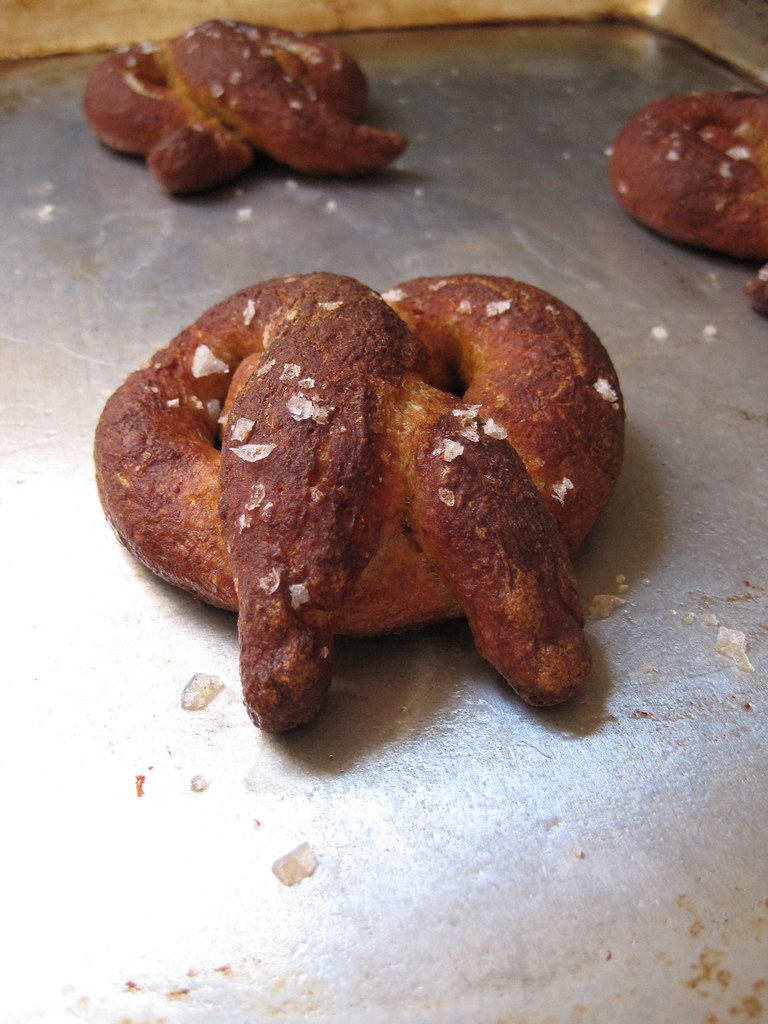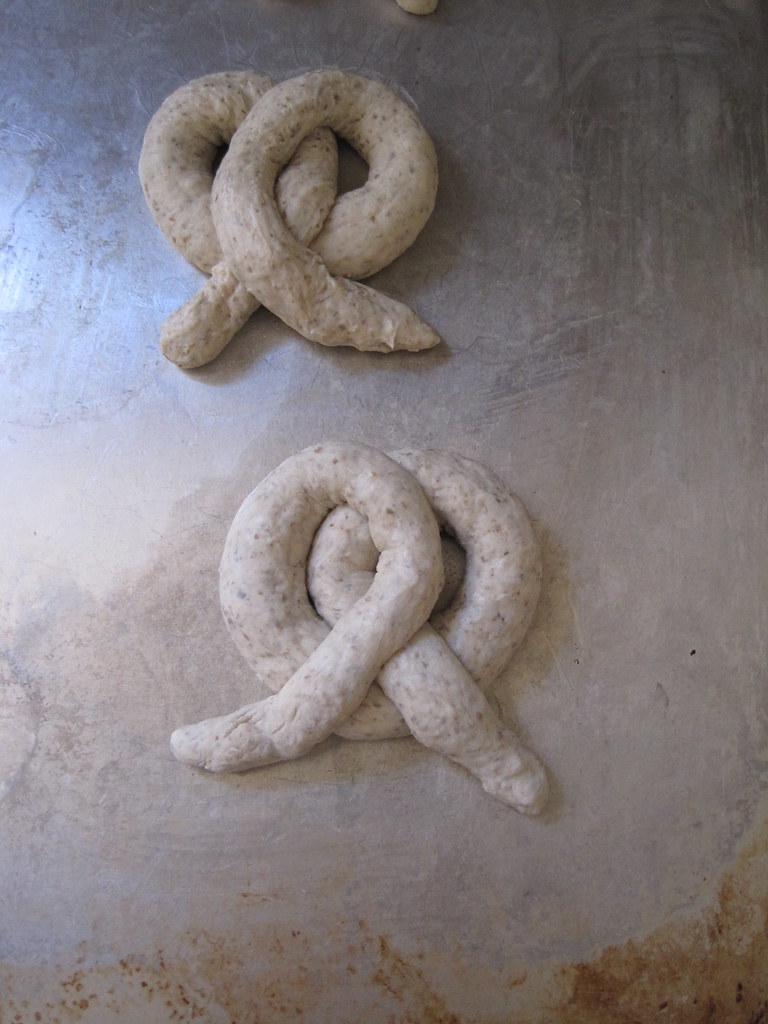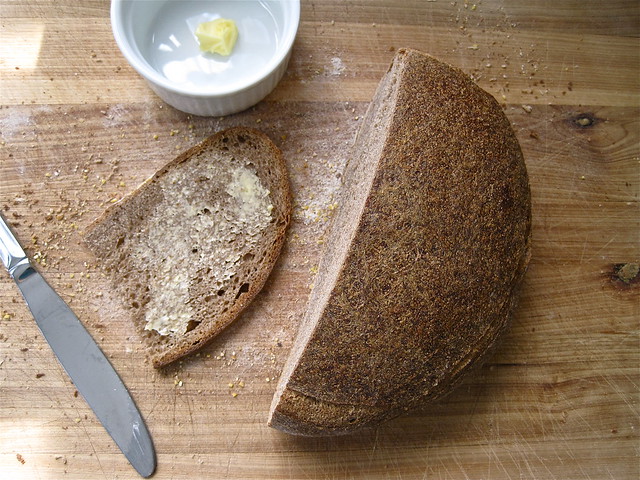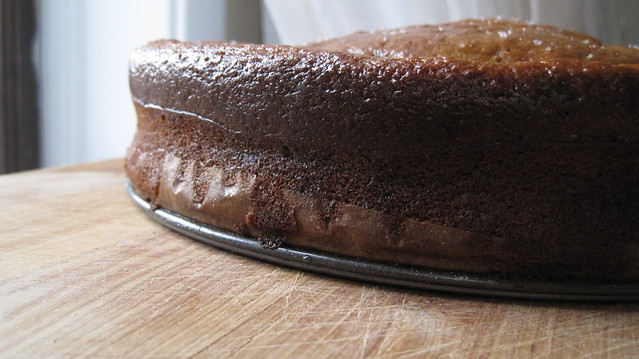
Where can you get good soft pretzels in Chicago? I have to say--I have no idea. It's embarrassing how little my boyfriend and I venture out into the city beyond the bounds of our sleepy neighbourhood. When we were out with our Toronto friends last week, we knew almost as little about some of the neighbourhoods we visited as they did. Like, when
the Publican didn't work out on Saturday night (8 people, no reservation...oops), we had no idea where else we could eat in the West Loop (apart from the other Paul Kahan restaurants, of course). As I said, embarrassing.
But we're students--stipends don't fund a life of luxury, and unstructured schedules along with loads of literature to get familiar with mean that we at least feel as though we should be hard at work all the time. Besides, given where we live, it can be difficult to justify spending two or more hours on the CTA just to get dinner, even phenomenal dinner.
And that's where these gorgeous homemade pretzels come in. Hit with a sudden craving and more or less stranded in my neighbourhood, I knew that the only way to get my fix was to make my own...even if I had to wait a few hours. I turned to Kim Boyce's Good to the Grain for help: soft rye pretzels, yes. And with a bit of mixing and kneading, a quick dip in a baking soda bath, and a little oven time, these mahogany beauties were ready for my whole-grain mustard treatment.
While certainly fine warm from the oven, these pretzels, I found, were best an hour or two later. Sure, they didn't quite have that right-out-of-the-oven goodness that you only get when you grab them from a still-hot half-sheet. But given that time to cool, they took on a different character. They had a little more chew to them, and they were wonderfully buttery and salty, with a slight sweetness and an earthen heft, lent to them from the pumpernickel flour. Seriously worth the wait.
Soft Rye Pretzels
Adapted from Kim Boyce's Good to the Grain
Makes twelve pretzels
From KB: These pretzels are soft, chewy, and flavourful, with a slight sourness that comes from boiling the pretzels in a baking soda bath. The baking soda also gives the pretzels their traditional dark mahogany colour. Be sure to boil only a few pretzels at a time and to use the bath for only a single batch of the recipe--otherwise the baking soda water reduces too far and leaves a metallic bite to the dough. A simple dusting of sea salt, especially flaky Maldon salt, is the best finish to these. Serve a basket of pretzels with a pot of whole-grain mustard.
4 to 5 tablespoons unsalted butter, melted
Dough:
0.25 oz / 1 1/4 teaspoons instant yeast
0.5 oz / 1 tablespoon honey
4.15 oz / 1 cup pumpernickel or another rye flour
10.6 oz / 2 1/2 cups all-purpose flour
0.25 oz / 1/2 tablespoon fine sea salt
Bath:
1/2 cup baking soda
To finish:
Coarse sea salt, like Maldon
In a large bowl, mix together the yeast, flours, and salt. Add the honey and 1 1/2 cups of water. Stir to combine.
Dump the sticky dough onto a floured surface and knead. Add up to a 1/2 cup of all-purpose flour, as needed, until the dough is tacky but not sticky. Knead for about 7 minutes, until the dough is soft and supple. It should pass the
windowpane test. (Don't knead for much more than 7 minutes, as rye flours can make a bread gummy if kneaded for too long.)
Lightly brush a large bowl with melted butter. Using a dough scraper, scrape the dough into the bowl, cover with plastic wrap or a damp towel, and let rise for about 1 1/2 hours, or until doubled in size.
While the dough is rising, place two racks at the top and bottom thirds of the oven and preheat to 450 degrees F. Brush two baking sheets generously with butter.
Once the dough has doubled, gently pour it from the bowl onto a lightly floured surface. Cut the dough into 12 pieces (about 2.5 oz each). Take each piece of dough and roll it into a snake about 17 inches long, with thinly tapered ends. Don't flour your surface as you roll; the slight stickiness enables you to roll the dough out evenly and quickly. Form the dough into a pretzel shape by folding one-third of the left side over the centre of the snake, and then one-third of the right side over the left. Place the shaped pretzels onto the prepared baking sheets. Let the pretzels proof for 15 to 20 minutes.
Meanwhile, for the bath, fill a large pot with 10 cups of water and bring it to a boil. Once the pretzels are proofed and the water is boiling, add the baking soda to the water.
To poach the pretzels, lift 2 or 3 pretzels, depending on the surface area of your pot, into the bath. Boil each side for 30 seconds, use a strainer to remove the pretzels, pat any excess water with a towel, and transfer them back onto the buttered baking sheets. Boil the remaining pretzels. Brush with the remaining butter and sprinkle liberally with salt.
Bake for 15 to 18 minutes, rotating the sheets halfway through. The pretzels should be dark mahogany in colour. Transfer them to a rack to cool. These pretzels are best eaten the day they're made, ideally within a few hours.
Don't want to eat all those pretzels in one sitting? After the first proofing, divide the dough between the number of pretzels to be made right away and proceed with the instructions above with that portion of dough. With the rest, press on it gently to de-gas, form it into a ball, and return it to the buttered bowl and cover with plastic wrap. Leave it in fridge for up to two additional days. When ready to make more pretzels, take the dough out and divide it into equal portions (about 2.5 oz each), cover with plastic wrap or a damp towel, and leave for an hour on the counter to take off the chill. Proceed as you did with the others.








